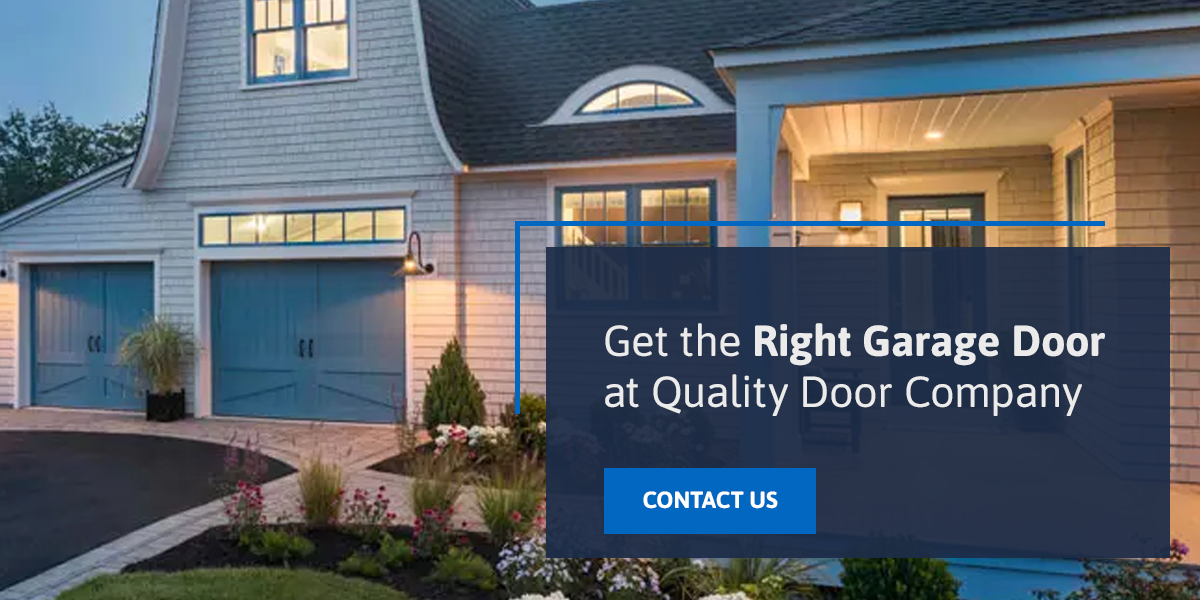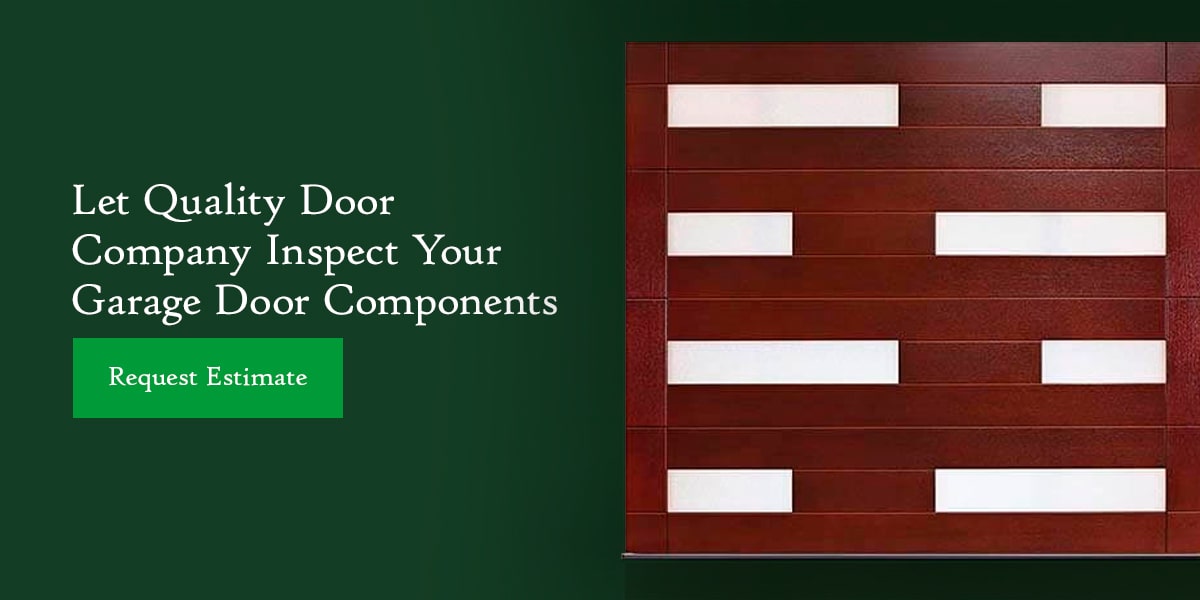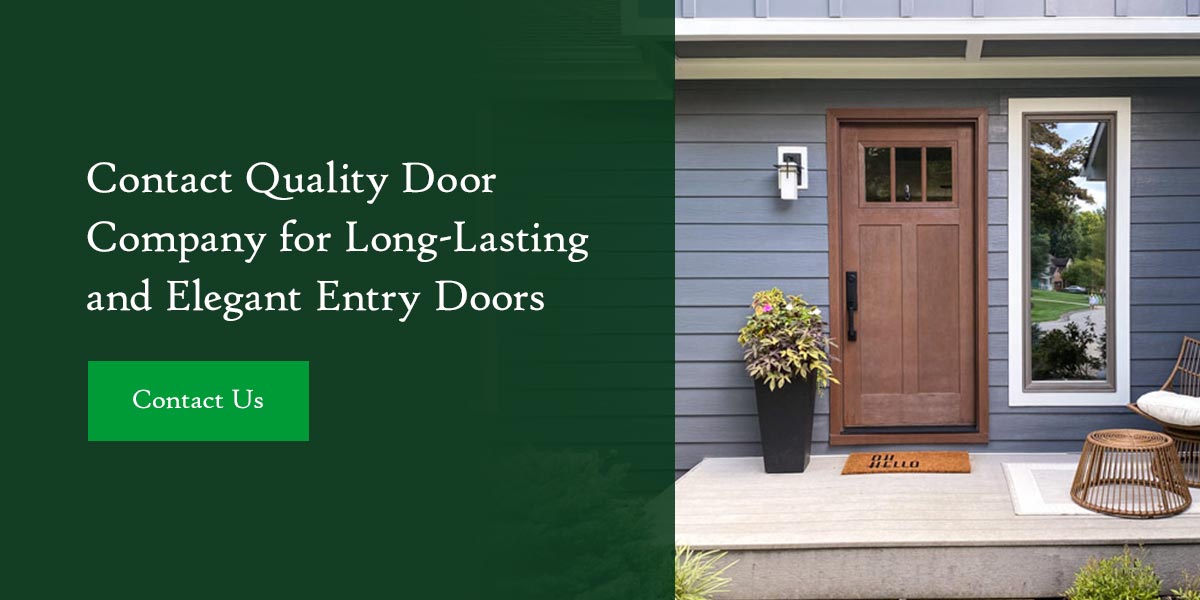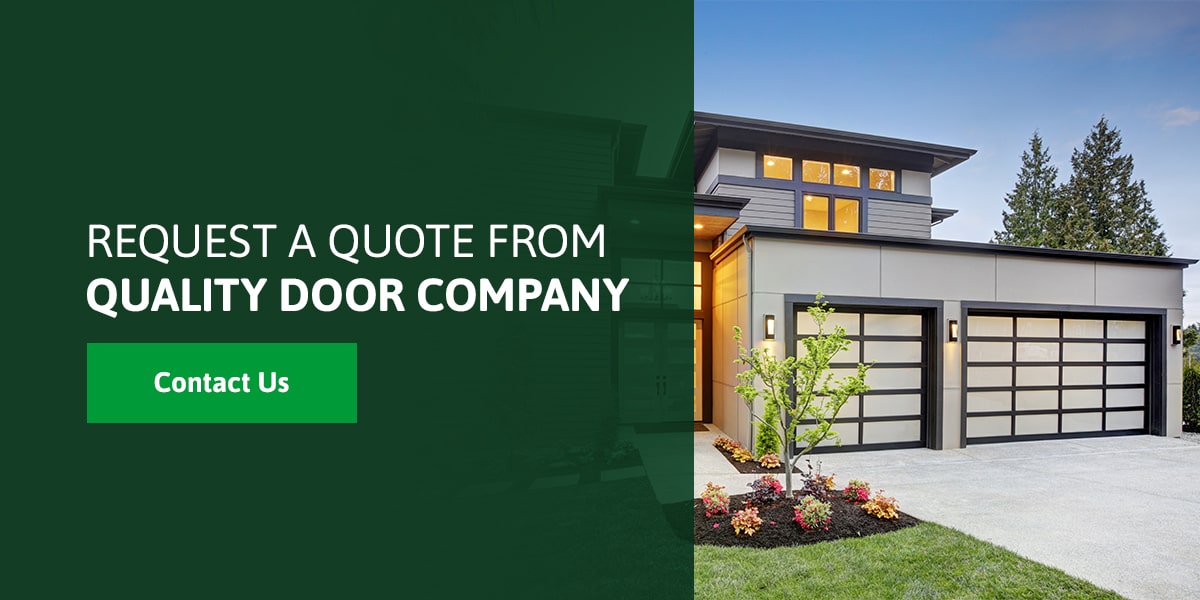Best Time to Have a Garage Door Installed
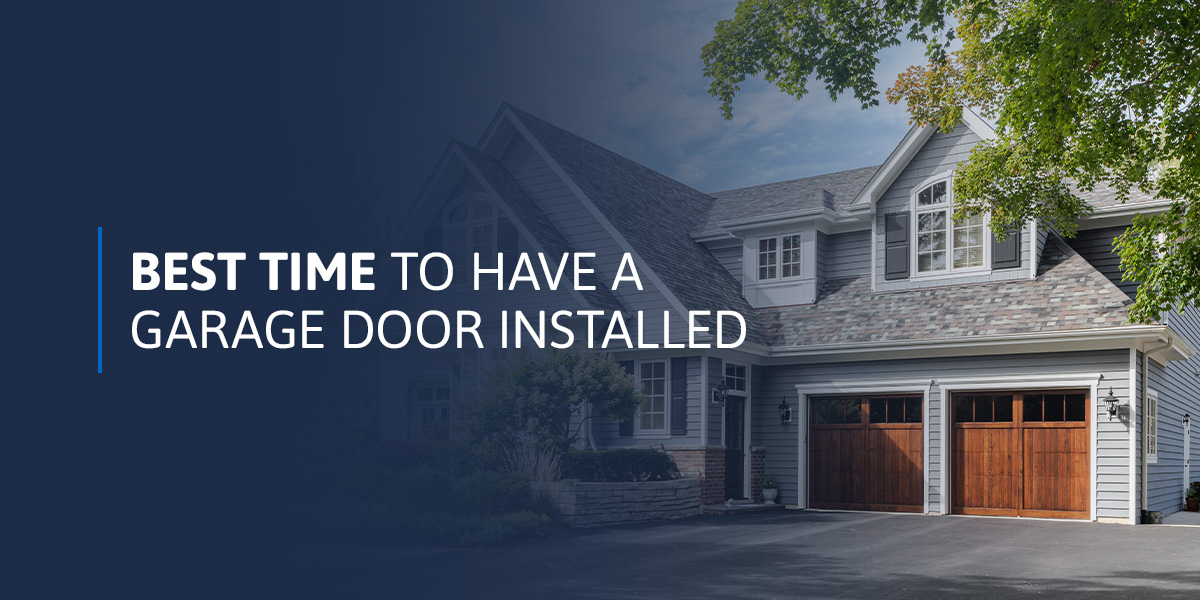
Your garage door may last for years, but there comes a time when you need an upgrade. Whether it’s because it constantly breaks down, even after numerous repairs, or due to normal wear and tear, installing a new garage door may be the right fit for your garage. While some cases may necessitate a speedy replacement, if you’re just looking for a garage door upgrade, the timing can make all the difference.
Best Season to Install a New Garage Door
The best time to have a garage door installed is when it’s broken or causing you trouble. There are some issues that require prompt repairs, but signs like slow or loud operation can indicate your door is reaching the end of its life span. If you’re able to plan ahead for your garage door replacement, you may want to consider waiting until spring. As a homeowner, timing is an important factor to consider whenever you have a renovation project, and garage door replacement is no exception. Knowing when to install a new garage door can make a big difference in the outcome.
Doing the installation in winter can be troublesome because of the snow, unpredictable conditions and shorter days. The cold will make the process take longer than usual. In addition, many garage door companies are busy during winter as they focus on repairs and other emergency calls.
Summer provides better conditions than fall and winter for garage door installation, but the humidity and heat can make it uncomfortable for the technicians. Additionally, since many homeowners leave their home improvement projects until the summer, you might encounter more scheduling difficulty. This leaves spring as the best season to install a new garage door if you can wait until then.
Why Spring Is the Best Season for Garage Door Installation
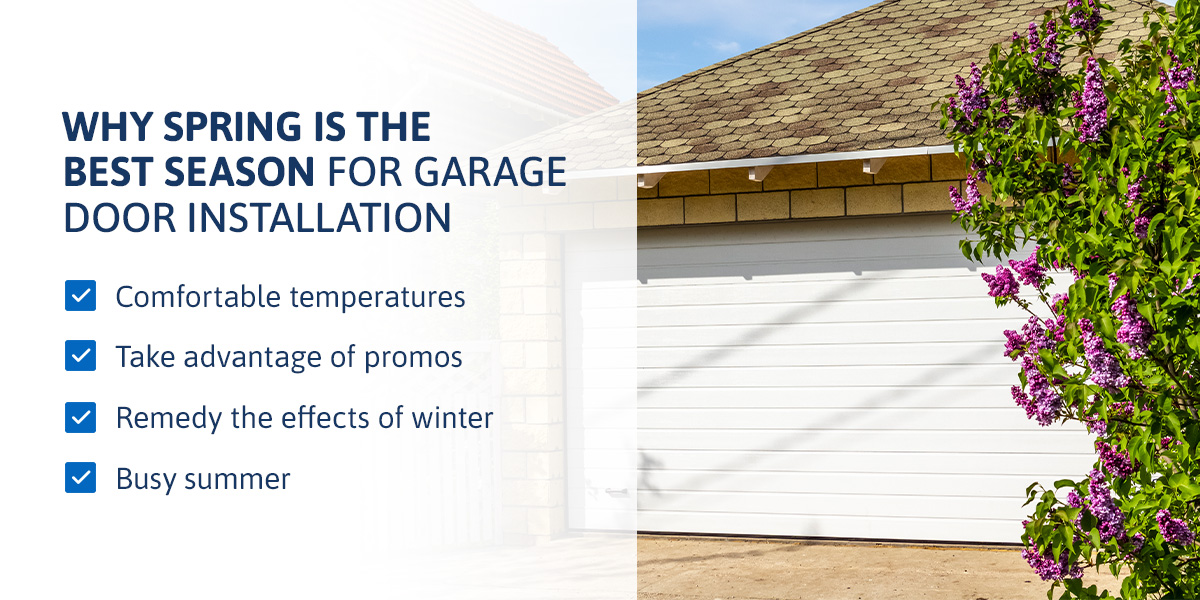
An emergency in any season will force you to replace your garage door urgently, regardless of the conditions. However, if you’re planning ahead for your garage door replacement, choose a season with the most favorable conditions. Here are some of the reasons why spring may be the best time for replacement:
- Comfortable temperatures: Garage door installers can work comfortably during spring. In addition, materials used during installation are safe when left exposed.
- Take advantage of promos: The winter season is slow for garage door businesses, and most companies offer attractive promotions on products and installations during spring. Manufacturers of garage doors also offer promotions during this season.
- Remedy the effects of winter: Winter can be harsh on garage doors. When the door’s chain, rollers, cable and spring are covered in frost, their performance can decline. In addition, freezing weather can cause cracks in the frames and panels. If you notice signs your door is struggling to get through the winter, spring is a great opportunity for a new door.
- Busy summer: For some families, summertime is packed with lots of activities and trips. You may not have time to spend hours at your home supervising renovations. The perfect time to have the door replaced is spring to save you more hours you can spend on other activities during summer.
How Long Does It Take to Install a Garage Door?
It takes minutes to schedule a garage door installation, but you may wonder how long it takes to install it. Many factors determine how long it takes to replace the door. These factors include:
- New construction: Installing the door in a new building takes less time because there is no door to be removed to create space. The installation should take two to three hours.
- Size: Size is one of the most significant factors determining how long it takes to install the door. A large door will take longer to replace than a smaller model.
- Similarity: If the new and existing doors are similar, the installation should take a few hours. This is because the new door is compatible with the available space and structure.
- Installers’ experience: Installing a new door can be challenging, and that’s why it’s important to call a professional. Professional garage door installers will not take as long to do their job because they have the skills and experience to assess your garage and adapt to your needs. Accidents and mistakes while attempting to do it yourself (DIY) can also significantly extend the service time.
- Weather conditions: Snow, rain and windy conditions can make the installation process take longer.
- Existing structure: If your existing structure needs modification to install your new garage door, this will extend the installation time frame. Parts like back jambs, ceiling beams and mounting pads may need to be replaced or modified.
What Is the Average Price for a New Garage Door?
The national average cost for a new garage door is $1,200. However, the price can vary depending on various factors, such as the materials used to manufacture the door.
The following are the main factors that determine the price of a garage door:
- Material: Common garage door materials are steel, fiberglass, aluminum and wood. Aluminum and steel are the cheapest options, while wood is often the most expensive.
- Type of door: Common types of garage doors include carriage, glass, standard panel, French, tilt-up, roll-up and retractable. The most cost-effective option is the standard panel type, while the most expensive is carriage.
- Size: You can buy your garage doors in three-car, two-car and one-car options. One-car garages cost less because they use the least amount of materials.
Besides the cost of a new garage door, you may also want to consider the installation cost. Some of the factors that come into play to determine the cost of garage door installation are labor, electrical work, add-on accessories, insulation and location. Installing an automatic door will cost you more than a manual door. Smart garage door openers may come with higher costs due to their more advanced features.
In most parts of the country, a garage door replacement is considered a minor home improvement, and you’ll not need a permit to change the door. However, a permit is likely required if you plan to make changes to accommodate the new door. These changes may include removing a pedestrian door, making a door opening wider or widening a wall.
Contact Quality Door Company for Your Garage Door Installation
Installing a new door may be the most cost-effective solution if your current door keeps on breaking down even after repairs. You may also need a new door if your current one has reached or exceeded its projected life span. Spring is the best time to do the replacement because of the favorable weather conditions and attractive promotions.
At Quality Door Company, we can install a new garage door for you at any time of year. You can choose from our range of high-quality garage doors made by Cornell, Clopay® and LiftMaster®. We specialize in residential and commercial garage door sales, installations and repairs.
Contact us for more information and request an estimate for a new garage door today.
How to Measure for a New Door
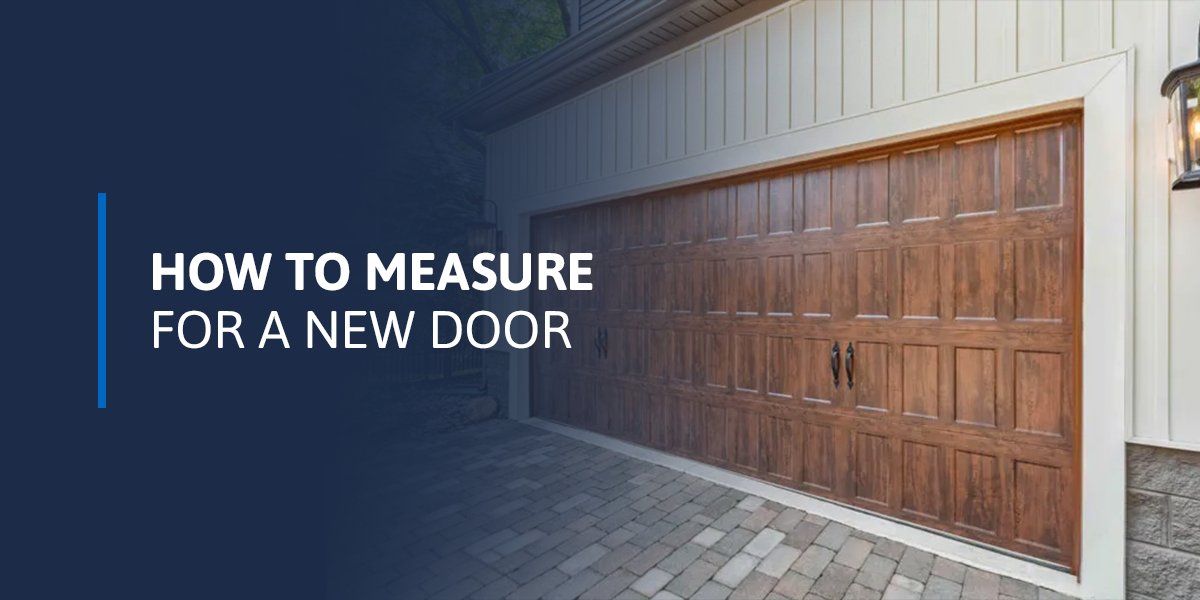
If you’re working on a home renovation project that involves replacing your garage door, you’ll want to take accurate measurements before shopping for doors. The last thing you want is a replacement door that’s too big or too small for the opening. Correct measurements will help you order the right door size and door type for the unique dimensions of your garage space. It will also help your technician place a quote and ensure seamless installation.
Unless you opt for expert services that include assessment, measuring and installing the door, knowing how to measure a garage door is invaluable. This guide offers a quick overview of taking measurements for a new door.
Different Types of Garage Doors
While you’re not measuring the garage door itself but rather the opening, understanding the various types of garage doors available is useful when measuring garage room depth. Considering how the doors open makes a difference, you want to ensure the space available fits your door of choice.
Here are the common garage door systems to consider before taking measurements:
- Sectional doors: Sectional garage doors lift smoothly along the tracks and roll back into the rear of the garage. They feature small horizontal panels connected to make up the larger panel. The design allows the smaller panels to move and stack vertically. A sectional door best fits a garage with ample backroom space.
- Up-and-over doors: Up-and-over doors are similar to sectionals in that they slot back into the garage when fully open, except for the canopy variety. The options are retractable, which lifts and slides back, and canopy, which lifts and forms a canopy.
- Roll-up doors: Roll-ups or rolling steel doors are made from steel slats that allow them to roll and coil inside a box above the door opening. They are different from traditional panel garage doors and resemble commercial overhead doors. If you find limited ceiling clearance when measuring, a roll-up door would be ideal, as its design maximizes compact space.
- Sliding doors: Also known as side-sliding, sliding garage doors are among the most versatile. The double-door options slide inside the garage to the opposite sides, while single-door options slide horizontally along overhead tracks. Modern styles are similar to sectional doors, except with vertical panels that slide to the side. These doors are excellent when there’s limited backroom space or headroom to install a door opener.
- Side-hinged: Side-hinged garage doors operate like other doors in your home. They are attached to the frame with hinges and swing outside to open. These types feature a traditional door design that’s lightweight and easy to use without the need for an automatic operation assembly. A side-hinged door would be ideal if you lack overhead space or prefer manual operation.
How to Prepare for Measuring
You will need the right tools to measure a garage door and know how to use them correctly. These are:
- Tape measure: A proper tape measure should be 25 feet long as it allows you enough tape room to cover the entire width and height. It should be a retractable tape measure because the stoutness makes it easy to keep the tape tight and straight without skewing readings. When measuring, pay attention to the different units. You could take a moment to refresh on tape measures to ensure accurate readings.
- Paper and pencil: You’ll need somewhere to write everything down to help you remember the readings. Remember, you’ll need to label the differences in location, such as the widths and heights, and determine whether they are on the left or right side of the door.
- Ladder: You may need a ladder to reach higher areas like the headroom.
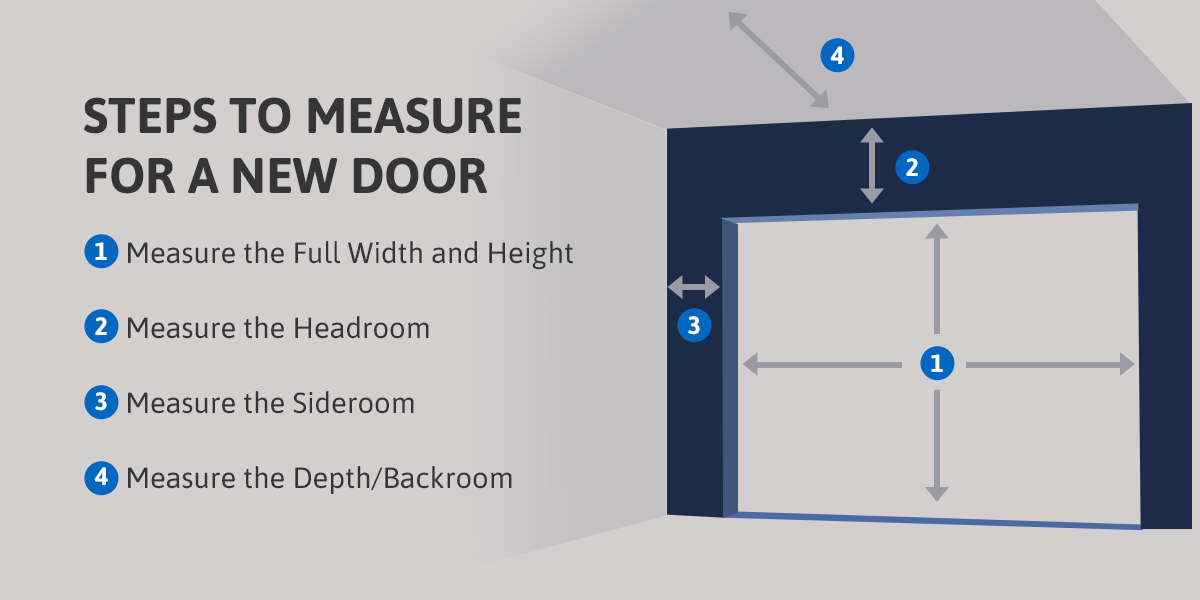
Steps to Measure for a New Door
Here’s a step-by-step process for measuring a garage door opening replacement:
1. Measure the Full Width and Height
Your new garage door needs to fit inside the full width and height of the opening. Measure the distance from the top of the opening to the floor and from one side of the frame to the next. Since the width and height of the opening determine the size of the door you get, use a level to identify or rule out possible unevenness on the floor.
2. Measure the Headroom
This is the distance between the ceiling and the top part of the door. You can use a ladder to obtain the measurements. Alternatively, extend the tape from the ceiling to the floor and deduct the full height of the door from the measurements to get the headroom readings.
Remember, you need ample space in this area if you want to install a garage door opener — at least 12 inches for mounting the header bracket. Take note of obstructions limiting clearance, such as piping or a drop ceiling.
3. Measure the Sideroom
The sideroom is similar to the headroom but is located on each side of the garage door opening. If you have multiple openings for multiple doors, measure the distance between each opening. For multiple door openings separated by a column or a wall, the sideroom is the distance between the opening and the wall or column.
4. Measure the Depth/Backroom
The backroom is the area from the door opening all the way back. To measure unobstructed depth, measure back all the way or up to the point of obstruction. The available space in this area will determine the type of garage door you get and is also for track installation. If the space is limited, you may have to consider a wall-mounted operator.
What Are the Standard Door Sizes?
Have you ever wondered what size is a garage door? Much like entry and interior doors, residential garage doors have varying sizes due to considerations for custom home builders. Knowing where your door falls helps with taking accurate measurements. Let’s look at standard garage door sizes and common custom-build options on the market.
Standard garage door sizes can vary from place to place. However, the common dimensions for single garage doors are 8 or 9 feet wide by 7 feet tall, and double garage doors measure 16 feet wide by 7 feet tall.
However, every home’s needs vary, so standard custom-build sizes like 9 feet wide by 8 feet tall for single doors are common. Custom double doors can range from 16 feet by 8 feet to 18 feet by 12 feet. While these are the standards, some manufacturers often make customized exceptions to match your unique dimensions and preferences.
Get the Right Garage Door at Quality Door Company
Measuring a garage door is straightforward once you know what to measure and how to ensure accuracy. If you’re uncertain about choosing the right door for your space or navigating your unique garage space design, seek expert assistance. As a homeowner in Western Michigan, you can rest easy by working with Quality Door Company.
We are an award-winning company with over 40 years of experience installing and maintaining various garage door brands. Browse our high-quality garage doors and openers from top brands or request an estimate to work on your garage door with industry experts.
How to Fix a Noisy Garage Door
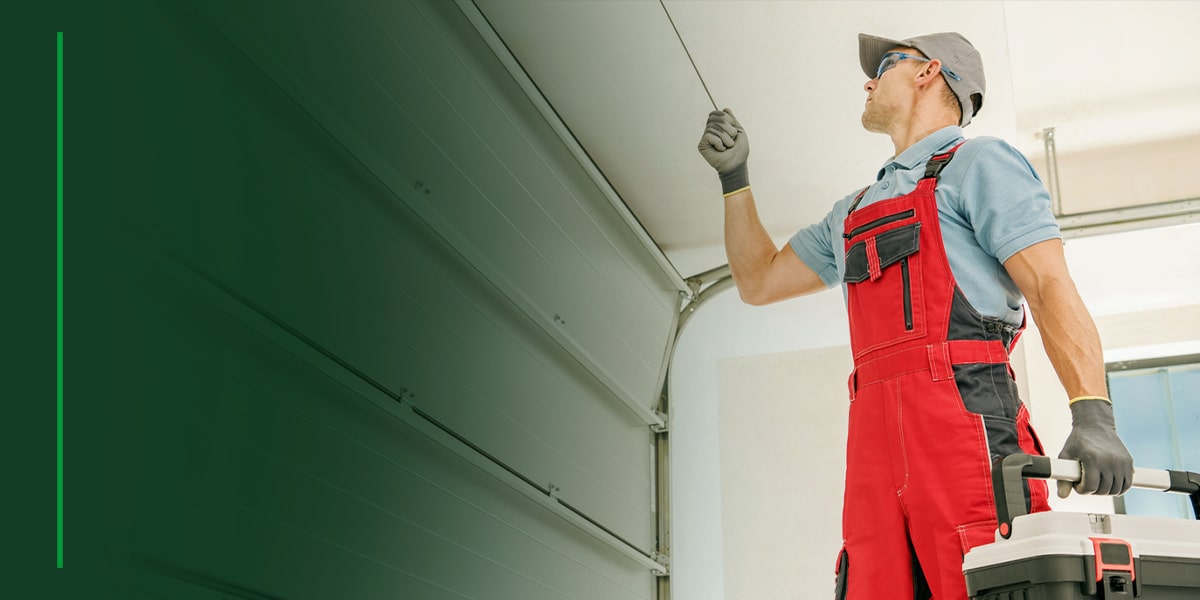
The last thing you want is your garage door to be a nuisance to anyone. Its purpose is to provide shelter and protection for your family, vehicle and other assets. When you notice your garage door making noise, you’ll want to get to the bottom of the problem to see what’s causing the unbearable racket before it worsens. Though you may not be able to fix some parts yourself because of the possible risk of injury, you can always contact a garage door contractor to assist. If you notice anything preventing your normal door movements then it’s best to call to professional to diagnose the issue.
This article will highlight a few causes of a noisy garage door and what you can do to fix it. Keep in mind that many of these issues can be prevented or addressed through regular maintenance checks. No matter how old or new your garage door is, it’s never too late or too soon to get a tune-up from a professional.
Lubricate the Necessary Parts
A garage door has many moving parts that need lubrication to operate efficiently. With regular greasing, you could ease or eliminate the noise. Though most steel parts are OK to lubricate, you should be careful not to get grease on nylon or other synthetic materials needed for the door to work. Also, ensure the lubricant you use is safe for garage door part application. Though you may think WD-40 will work as a lubricant, silicone spray is a better option and will ensure your tracks stay dirt-free for longer.
Which parts should you routinely lubricate and clean?
- Tracks: The tracks are vital to the garage door’s mobility. You shouldn’t lubricate them directly, though they will likely come into contact with lubrication used for steel rollers. Wiping the tracks with a clean cloth to remove dust and dirt will create optimal conditions for the rollers to glide soundlessly. If you are going to lubricate the tracks be sure to avoid common household spray lubricants like WD40 and use a proper garage door lubricant to avoid any residue.
- Rollers: Garage door rollers fit into the tracks and ensure the door moves smoothly. There are two types of rollers available — steel and nylon. The advantage of nylon rollers is that they are lighter than steel and, therefore, quieter. The drawback is that you can’t lubricate them as you would do with steel rollers. If your garage door has steel rollers, occasionally apply a small amount of grease to reduce unwanted noise.
- Springs: Torsion springs are above a garage door, while extension springs are on the sides. You don’t necessarily have to lubricate both types of springs, but you can apply a thin layer of grease on the coils to keep them flexible. The better oiled they are, the less noise the springs will produce.
- Bearing plates: Bearing plates at the end of torsion spring shafts require lubrication to support the spring system and help reduce friction and subsequent noise.
- Hinges: Hinges are especially susceptible to wear and tear and need more lubrication than other parts. Well-oiled hinges ensure smooth, silent operation.
- Locking mechanism: Though the locking mechanism is not part of the garage door’s mechanical structure, you can also lubricate it to reduce noise levels when opening and closing it.
If you can no longer maintain any of the parts listed above with regular greasing, it may be time to replace them. Worn components like rollers, springs and tracks all increase noise levels when they start squeaking and screeching.
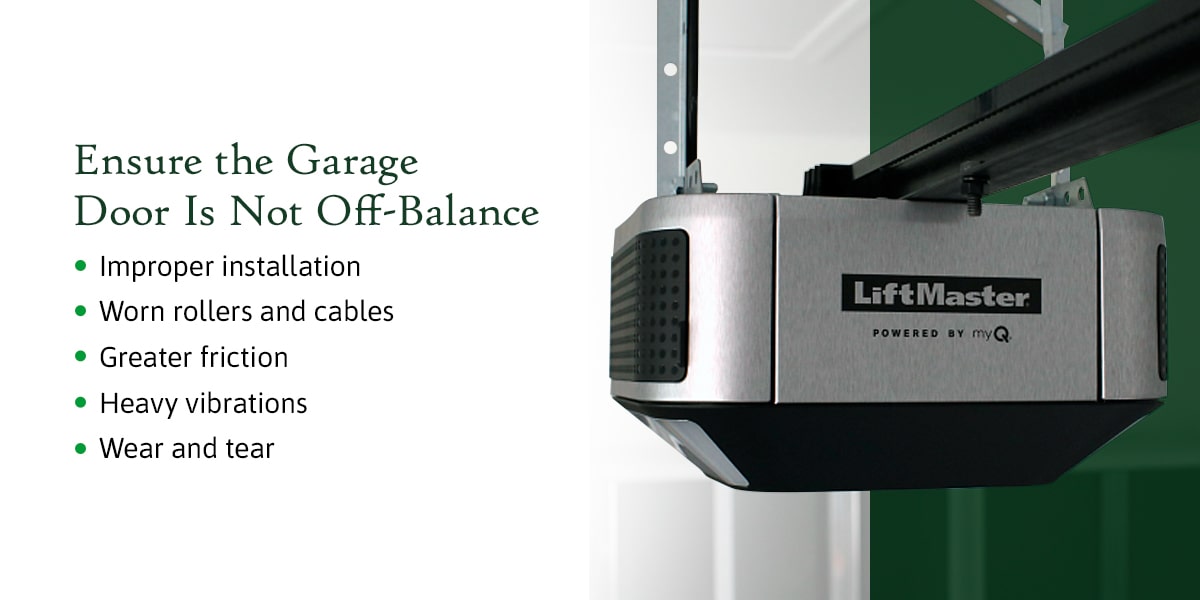
Ensure the Garage Door Is Not Off-Balance
An imbalanced garage door will pressure the opener, rollers, springs and other parts to work harder, creating friction that can be noisy. Here are a few reasons your door may be off-balance and your garage door opener is making noise.
- Improper installation: Shoddy garage door installation can have severe consequences. Professionals use specialized tools to fasten bolts, screws, springs, hinges, etc. You may hear sounds that signal something is wrong — like unusual slapping, creaking and vibrating — when it should open and close smoothly. While the noise element is a factor, safety comes first. The best way to ensure safety and prevent injury and damage is to consult an experienced garage door technician. You will also enjoy a noise-free garage as a result.
- Worn rollers and cables: When rollers experience increased strain because of an uneven garage door, they will wear out quicker or come off the tracks. They will make noise as they struggle to move under the pressure. Replacing the old rollers with new, working ones will solve the noisy garage door problem. The strain also affects cables, which are more prone to breaking because of the increased pressure. A scraping noise could indicate a cable issue, which you should check out immediately.
- Greater friction: The imbalanced garage door’s heaviness will create friction as the panels and tracks work harder to support the added weight. The door will make a buckling, creaking sound as it moves slowly along the tracks.
- Heavy vibrations: An unstable garage door tends to be shaky. It vibrates and rattles every time you open and close it. The more the parts shake, the louder the noise will be.
- Wear and tear: If your garage door is old and has seen daily use for years, the resulting wear and tear can cause it to be off-balance. You will hear grinding and other loud noises during use. In this case, consider the effectiveness of a maintenance checkup to determine the extent of wear and tear damage.
Check for a Faulty Opener Motor
The type of motor opener that operates your garage door may determine the noise levels you can expect, apart from the motor being faulty or broken. Here are the common types of openers you will find.
- Chain drive openers: This motor uses a chain that rotates a trolley to open and close the door. It is the most popular because it’s durable enough to carry the weight of bulky, cumbersome doors. One notable drawback is that this type is a noisy garage door opener because of the consistent metal-to-metal contact while in use. Lose chains are often the cause of slapping sounds in this style of opener.
- Belt-drive openers: Instead of a chain, this opener uses a belt in the same way to control the door. Noise is minimal with this opener since the rubber belt inhibits noise.
- Screw-drive openers: These devices use a motorized steel rod to open and close the garage door. They have fewer moving parts than other garage door openers and require less maintenance, but still tend to be noisier.
- Direct-drive openers: The motor is the only part of this opener that moves along an aerial chain attached to the garage ceiling, making it the quietest option.
- Jackshaft openers: This opener is on the side instead of overhead. A motor turns a beam that allows the torsion spring to control the garage door. It is also not a noisy garage door motor.
Knowing which type of opener you have helps you understand why your door might be inherently louder or quieter. Various sounds can help you identify a faulty motor.
- Clicking: An electrical issue within your motor may be causing it to make a clicking or popping sound, so it’s best to have it checked out professionally.
- Rattling: Any time you hear rattling within a part like a motor, you can safely assume an internal component is loose or broken. You might have to disassemble the motor to inspect it.
- Shaking: Vibrations and shaking are common in motors that are misaligned or nearing the end of their life.
- Grinding: A grinding or buzzing sound could indicate that the gears in your opener are worn down or damaged. Immediately call a reputable garage door contractor to attend to this issue.
- Humming: This noise may sound like your opener is straining to work. It may result in laggy performance from a worn-out motor. Ideally, you should have it replaced at this point.
Let Quality Door Company Inspect Your Garage Door Components
Though you can inspect your garage door based on the noises you’ve identified, DIY garage door repairs are extremely risky. Quality Door Company hires experienced, talented technicians who know what to look for and what to do to restore your door with no hindering noises.
When you call us, we will gladly discuss your garage door noise issues with you. If you would like any other services or an estimate, fill out our contact form and we will get back to you in no time.
What’s a Good R-Value for a Garage Door in Michigan?
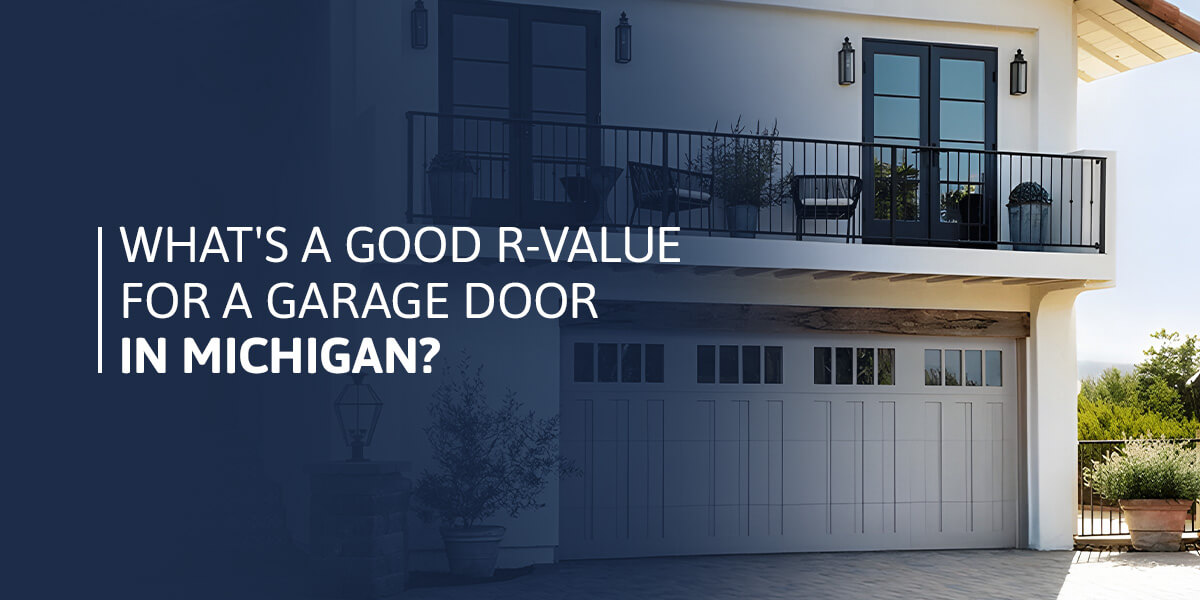
As a homeowner, you want your home to be efficient and comfortable. You might have tried many energy-saving tricks to reduce heating and cooling bills and regulate your temperatures. You have sealed cracks, changed your curtains and covered your fireplace to reduce the heat and cold. You’ve even changed your wall color. Despite these efforts, your energy consumption and bills continue increasing, and your home is still freezing or sweltering.
Your garage door might be the culprit, costing you money, time, effort and comfort.
What Are R-Values?
R-values measure insulation quality. Some materials offer high insulation and can prevent heat loss, while others are less insulated, losing warmth faster. For example, a non-insulated steel garage conducts hot air. It absorbs and removes the room’s heat.
A non-insulated garage door can also transfer in outdoor temperatures. An insulated steel garage door does not conduct heat, providing warmer indoor temperatures. The same principle applies to cold air.
R-values range from zero to 20.4, representing your garage door’s insulation capabilities. A higher R-value means your door is more insulated, letting out little to no heat. A lower R-value means your garage door is less insulated and loses heat faster.
Why Should You Insulate Your Garage Door?
Insulating your garage door can regulate your indoor temperature and help save money on energy bills. It can also provide a comfortable and enjoyable living environment. Here are some benefits of an insulated garage door.
Save Money
Increasing your temperature settings to total capacity can hike up your utility bills. With garage door insulation, you can keep your temperatures and maintain your cozy or cool indoor climate, spending less on energy bills.
Prevent Corrosion
Rain, snow, humidity, extreme heat and cold can cause rot, rust, warping and other corrosion. Insulation helps your door absorb less moisture and heat, preventing wear and deterioration.
Improve Your Energy Efficiency
You can set your heat or air conditioning to lower temperatures, reducing energy consumption. If making your home more sustainable is your priority, insulating your garage door can reduce energy usage and be environmentally friendly.
Enhance Your Curb Appeal
A cracked, chipped or discolored garage door can impact your exterior appeal. Insulated garage doors can withstand wear, helping maintain your door finishes and design.
Increase Your Property Value
An insulated garage door is an attractive selling point. Potential buyers can spend less on energy bills and door maintenance, saving more money long-term and increasing their return on investment.
More Space for Recreation and Storage
A well-insulated garage has so much potential. You can use it for extra storage and entertainment, or extend your living area with a home gym or office. Insulating your garage door can help you maximize your space throughout the year.
Limit Noise
Manufacturers fill your door with multiple insulation layers, compacting your internal structure. With restricted space, other internal components move around less, producing limited rattling when opening and closing your garage door.
Enjoy a Comfortable Living Space
Poor insulation can affect your living space. Hot days feel uncomfortable, especially when increasing your air conditioning temperatures does little to relieve the heat and humidity. Insulating your garage door prevents cold air from escaping, providing a cooler and comfortable internal environment.
Extend Your Garage Door Life Span
Installing insulation can make your garage door more rigid. You can prevent bumps, dents, cracks and holes and retain your doors in excellent condition for many years.
How to Select a Garage Door R-Value
Selecting a suitable R-value can require thought and research. The right insulation level can be a worthwhile and valuable investment. Your garage door R-value can depend on factors like climate, door usage, existing insulation, budget, home design and materials.
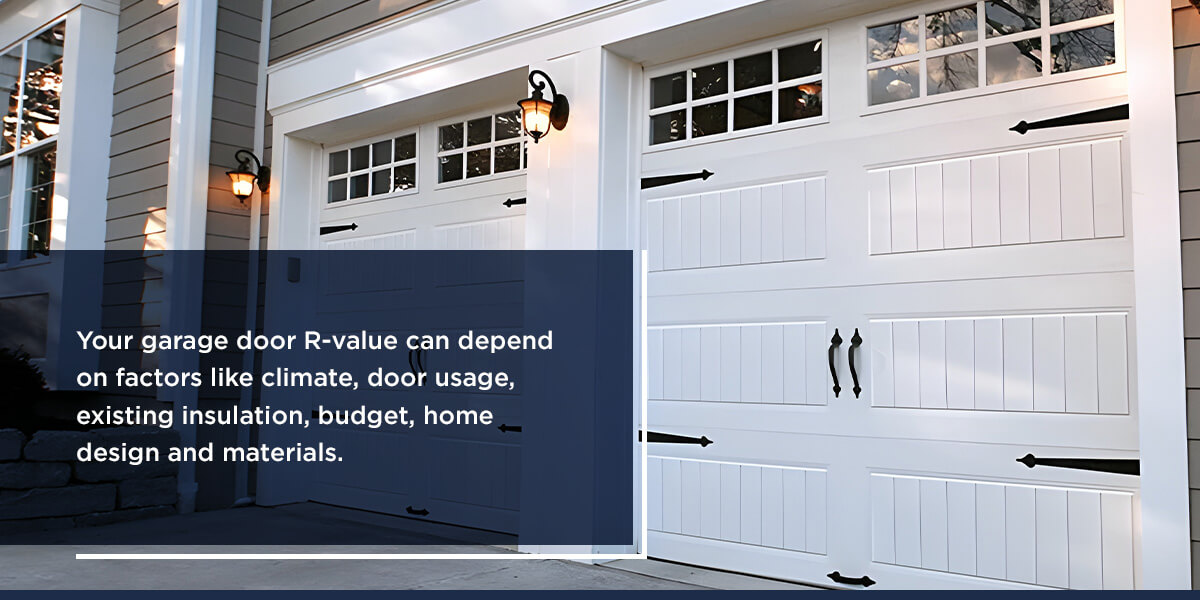
Climate
The climate is a significant consideration when selecting an R-value. You want your home to be comfortable year-round. For Michigan’s cold, damp winters and hot summers, higher R-levels can provide optimal insulation suitable for extreme temperatures. At the same time, lower values offer moderate insulation, ideal for mild weather. Understanding this variable can help you decide on a suitable R-value level.
Budget
Higher insulation levels are generally more expensive than moderate ratings. Manufacturers can use more insulation layers, increasing the R-value and price. The insulation material can also decide the cost. Foams like Fiberglas and polyurethane may cost more than polystyrene.
Design
Your home design can impact your choice. Is your garage attached or detached? Do you have a room above your garage door? All these factors can affect your home’s temperature.
Air escapes every time you open and close your garage door. Cold and hot air can seep into the rest of your home, affecting your living space and energy usage. You might want a higher R-value, like R-13 and up. A detached garage can require a lower rating, like an R-value of six or less.
Door Usage
If your garage is your home’s primary entry, you probably use it more often. Look for a higher R-value garage door to increase energy efficiency.
Internal Conditions
Heating and cooling systems can help regulate your indoor temperature. If your home has climate control, consider a moderate R-value level. Ratings between six and nine can offer suitable insulation for cold and hot weather.
Wall and Ceiling Insulation
Your R-value can depend on your existing insulation. Garage door insulation can be more effective when paired with wall and ceiling insulation. Insulating your garage door might block external temperature in a designated area. However, uninsulated walls and ceilings can transfer external temperatures, minimizing your garage door’s insulation.
Rely on Quality Door Company for Expert Garage Door Insulation
If you’re wondering how to keep your garage heated or what’s the best garage insulation for winter, we’re here to help. Quality Door Company understands the importance of saving money on energy bills and enhancing your living space. That’s why we offer solutions tailored to your needs and goals. Our skilled technicians are experts in their craft and provide knowledgeable insulation advice and services.
Find excellent garage insulation services near you or request an estimate today to get started.
Signs It’s Time for a New Entry Door
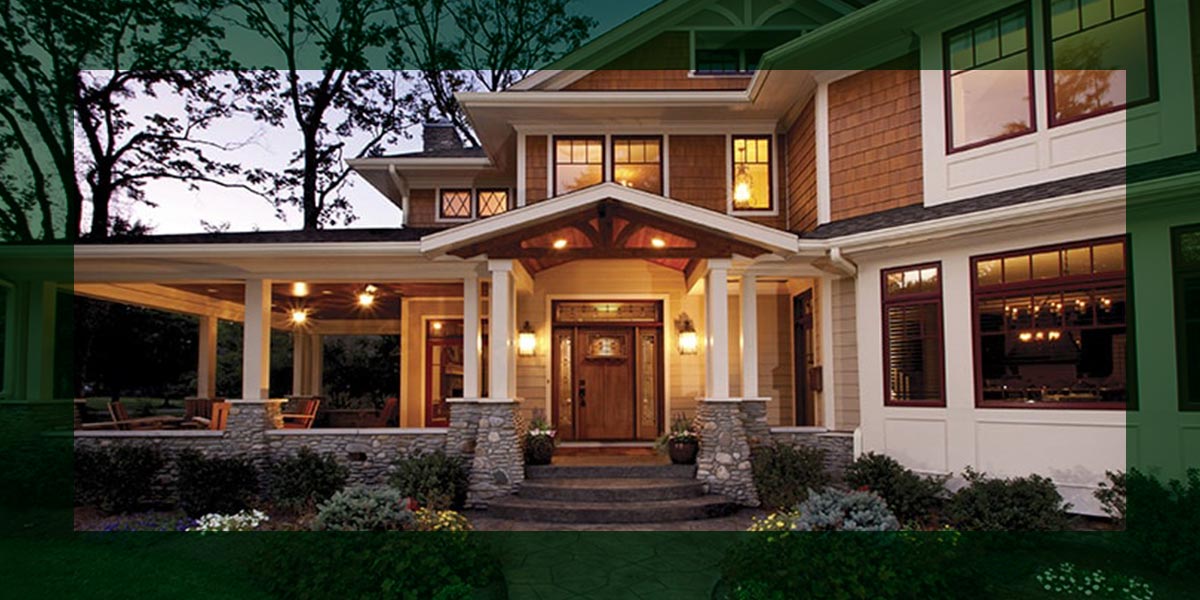
The front door of your home is more than an inviting entrance for family and friends. It also provides security, weather protection and curb appeal for your home. Over time, entry doors can become weathered and malfunction. While you may be able to solve some issues with a repair, it might be time to upgrade your front door with a new one.
Replacing your front door can increase your home’s energy efficiency, security and value. This article discusses the common signs to replace your entry door to help you make the decision.
Your Entry Door Is Damaged
A good reason to replace an entry door is that it’s showing signs of damage. Doors are subject to a lot of wear and tear, from lots of traffic to the weather or getting bashed by grocery bags when you bring them inside.
Let’s consider a few types of damage that may indicate you need to replace your entry door:
- Peeling paint: While repainting a door may seem like a quick fix, if your door is wood, there could be an underlying issue that a new coat of paint doesn’t solve. Wood doors expand and contract as the temperatures change, leading to warping and peeling paint that could allow moisture inside the door. If left alone, the door could rot and attract wood-eating insects.
- Dents: A residential door could become dented with just a well-intentioned kick to keep it open when your hands are full. Dents impact a door’s structural integrity and impact the door’s look.
- Squeaking hinges: You may be able to solve squeaking door hinges by applying a little lubricant or tightening ill-fitting screws. Yet sometimes, a squeaky entry door is simply failing. A nonfunctional entry door might pose a security issue by making it easier for intruders to enter.
Your Door Poses a Security Issue
One of the most important signs to replace your entry door is that it’s causing a security issue. You could have trouble locking your front door if the door settles over time and becomes misaligned with the door jamb. You may need to replace your lock system, which could involve an entirely new door.
Another security issue is when your entry door doesn’t fit correctly inside the door jamb. This issue could enable easier access to your home. Upgrading to a better-fitting door made of sturdy fiberglass can provide more peace of mind.
Your Door Causes Drafts
Your entry door should provide protection from the elements as well as from possible intruders. An entry door with gaps around the frame could allow gusts of air into your home from the outside. Drafty doors can be especially unpleasant in Michigan winters, when it’s cold for much of the year. A drafty front door also causes higher energy bills, which isn’t good for your wallet.
If your home’s front door causes drafts, a replacement could be the perfect solution. Installing a door that fits properly and seals to keep out the weather can make your home more comfortable and lower your energy bill in the process.
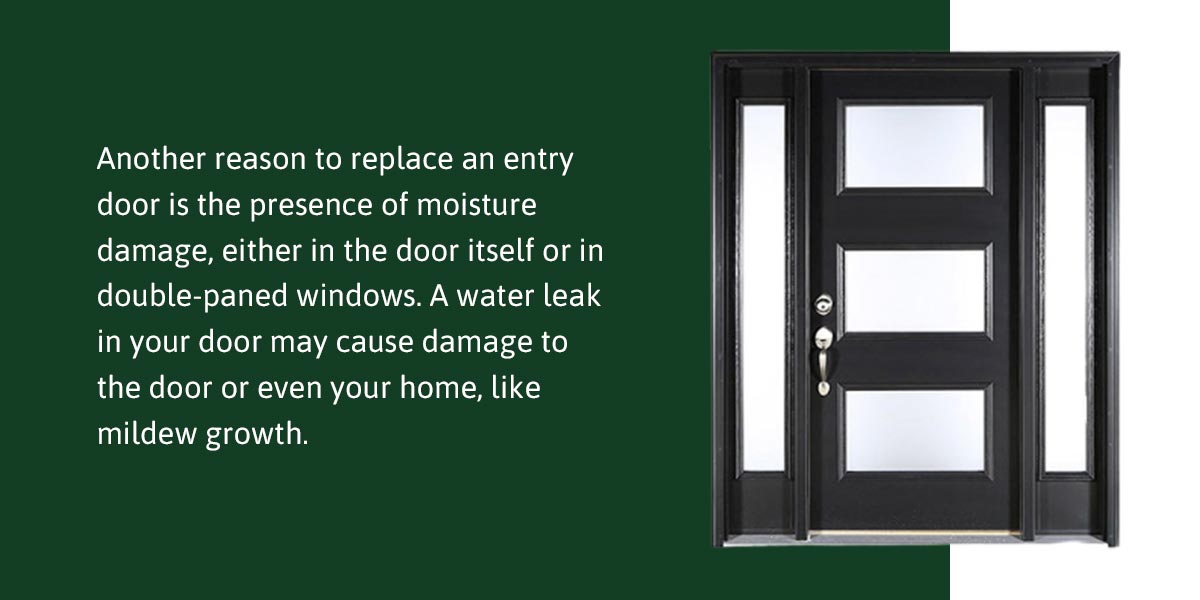
Your Entry Door Has Moisture Damage
Another reason to replace an entry door is the presence of moisture damage, either in the door itself or in double-paned windows. A water leak in your door may cause damage to the door or even your home, like mildew growth.
Look for rust to determine whether your door has moisture damage. Rust on the hinges or other metal door fixtures indicates moisture has gotten into the door frame or the door seams. Rust is a sign that your door is deteriorating, which means it’s time for a replacement.
You might also notice moisture inside the window panes on your door. If you see water droplets inside the window, you may have moisture damage due to a broken window seal. Replacing your entry door may be the best way to solve the issue.
Your Door Doesn’t Fit Correctly
Another of the signs to replace your entry door is that it’s difficult to open and close. A sticking door is most often due to weather-related expansion and contracting. These changes cause your door not to fit in the door jamb like it once did. A poorly fitting door also causes lost energy and drafts, making your home less comfortable.
If your door is difficult to open and close or you notice gaps around the door frame, you probably need an upgrade. Remember that gaps in your door frame can let in light, noise, drafts, insects and more. If you’re dealing with any of these issues, replacing your door could be the best solution.
Your Entry Door Is Outdated
The front door of your home may also need to be replaced when it looks outdated. Your entry door makes a statement in the design of your entire house. A carefully considered coat of paint or an updated style goes a long way in improving your home’s curb appeal and making a positive impression. An entry door refresh can also increase your home’s attractiveness to future buyers.
Whether you want to totally change your home’s aesthetic or just bring it into this century, here are a few front door replacement ideas:
- ARBOR GROVE™ fiberglass doors: A fiberglass door can emulate the grain and aesthetic of wood while providing superior protection from the elements. Our selection of Clopay® ARBOR GROVE™ fiberglass doors features the natural characteristics of wood in various grains and a wide range of panel, hardware and window options.
- CRAFTSMAN fiberglass doors: Craftsman architecture would be perfectly complemented by CRAFTSMAN fiberglass doors. These doors feature exquisite fir grain and stylish glass inserts.
- RUSTIC fiberglass doors: The cherry graining of Clopay RUSTIC fiberglass doors complements Mediterranean or American Southwest-inspired homes for a look of true craftsmanship.
Should Homeowners Replace Their Front Door Themselves?
If you’ve decided to replace your entry door, working with a professional is generally the best way to go. Replacing your front door yourself could lead to improper installation that doesn’t solve issues long-term. Work with an entry door installation company to benefit from front door installation by experienced technicians.
Contact Quality Door Company for Long-Lasting and Elegant Entry Doors
When your door is damaged, poses a security issue or looks outdated, replacing the front door of your home might be the best solution. An upgraded entry door protects your home, adds to its aesthetic appeal and may help lower your energy bills.
Quality Door Company provides energy-efficient, aesthetically pleasing and low-maintenance residential entry doors for homeowners across Western Michigan. As a Clopay Master Authorized Dealer®, we offer several Clopay door collections of beautiful, high-quality entry doors. We also provide exceptional service and can help you find the right door for your home.
To learn more, contact us today or visit one of our showrooms in Holland or Muskegon.
Guide to Choosing the Best Garage Door Material
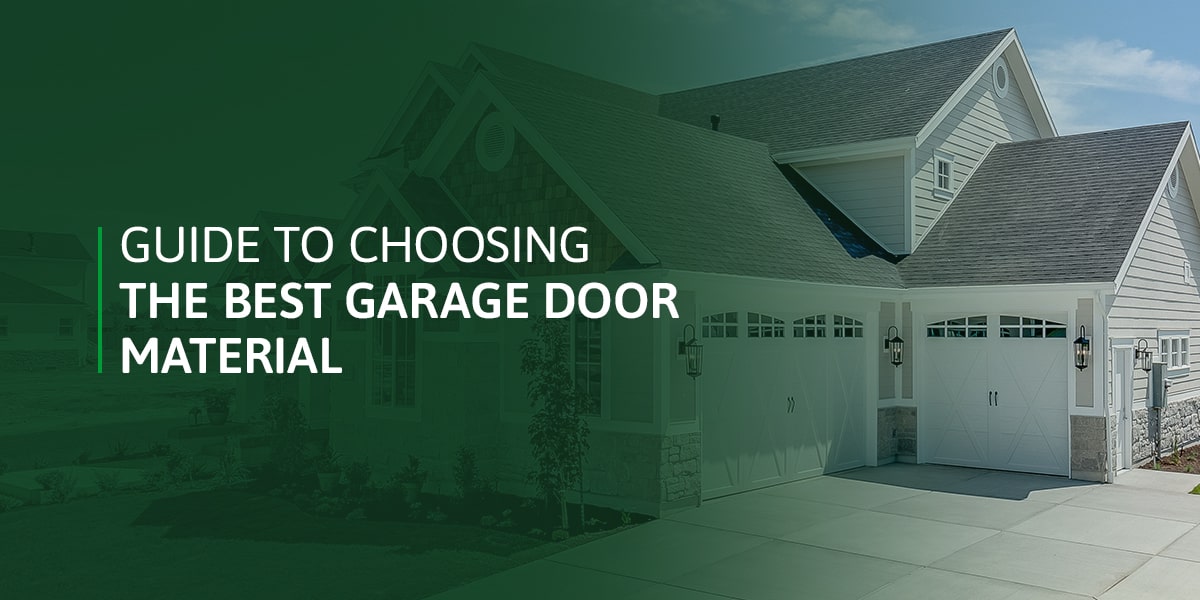
When choosing a brand-new garage door system for your home, the material of your door is one of the most important factors. There are many garage door material options to match your budget and lifestyle. As a Clopay® Master Authorized Dealer®, we offer high-quality residential garage doors of various materials and finishes. We offer several different garage door material options so you can find the best garage door material for your home or business. Once you’ve picked out the material, you can make an appointment to visit our Muskegon Showroom or our Grand Rapids showroom at your convenience (no appointment needed).
Table of Contents
- What Are the Different Types of Garage Door Materials?
- Benefits of Each Garage Door Type
- How to Choose the Right Garage Material for Your Home
- Pick Your Garage Door Material With a Local Expert
What Are the Different Types of Garage Door Materials?
Quality Door Company offers multiple garage door material options and collections.
Pick our Your Next Door With Quality Door Company
Steel
High-quality steel garage doors usually contain two layers of galvanized steel with a primer or paint on the surface. Any paint or finish can mimic other materials and complement the rest of your home. To enhance steel doors’ energy efficiency, most manufacturers add a layer of polyurethane or polystyrene insulation, but you can also get it without extra insulation.
Some of our steel garage doors include:
- CLASSIC™: A CLASSIC™ steel garage door offers your choice of long or short panel styles and several insulation and color options.
- CLASSIC™ Value Series: The garage doors in our CLASSIC™ Value Series include budget-friendly options with a handful of colors.
- CLASSIC™ Value Plus Series: The CLASSIC™ Value Plus Series provides a standard steel garage door with insulation and several color choices.
- BRIDGEPORT™ STEEL: The recessed panels in the BRIDGEPORT™ STEEL garage door series resemble traditional wood stile and rail door designs.
- GALLERY®: These carriage house garage doors have grooved panels to give your home a sense of rustic charm.
- MODERN STEEL™: For a sleek, clean look, MODERN STEEL™ garage doors are ideal for mid-century modern and contemporary homes.
Wood
Wood garage doors have layers of wood panels specially treated to prevent warping and swell rot during temperature changes. Even though our wood options have a naturally beautiful color alone, you can choose from paint colors, stains and wood finishes to customize your door.
Explore the qualities of the following wooden garage doors in our collection:
- CLASSIC™ WOOD: The garage doors in the CLASSIC™ WOOD feature handcrafted cedar, hemlock or redwood panels with various design and color options.
- RESERVE® WOOD CUSTOM series: The RESERVE WOOD® CUSTOM series lets you create a one-of-a-kind wooden door based on your unique design preferences.
- RESERVE® WOOD LIMITED EDITION series: The carriage-house-style garage doors in the RESERVE WOOD® LIMITED EDITION series provide durable insulation and visually appealing wood finish options.
- RESERVE® WOOD MODERN series: The RESERVE WOOD® MODERN series includes sleek, modern garage doors with clean lines and warm colors.
- RESERVE® WOOD SEMI-CUSTOM series: The RESERVE WOOD® SEMI-CUSTOM series offers several panel styles and color options to complement your home’s exterior.
Faux Wood
As an alternative material option to solid wood garage doors, faux or composite garage doors feature panels with a combination of wood and plastic fibers. These garage door options include high-density fiberboard with realistic details that make the door look like various real wood types, such as grooves and overlays. Like steel doors, composite wood garage doors have polyurethane or polystyrene insulation for additional weather protection and durability.
As your local Authorized Clopay Dealer we carry some of the best Faux Wood Doors available to withstand the Michigan weather:
- CANYON RIDGE® CARRIAGE HOUSE (4-Layer): The products in the CANYON RIDGE® CARRIAGE HOUSE (4-Layer) feature steel garage doors with faux wood overlays and ULTRA-GRAIN® wood finish.
- CANYON RIDGE® CARRIAGE HOUSE (5-Layer): The faux wood garage doors in the CANYON RIDGE® CARRIAGE HOUSE (5-Layer) feature the look of a traditional swing-out carriage house door with the convenience of an automatic overhead door.
- CANYON RIDGE® MODERN series: The CANYON RIDGE® MODERN series includes insulated faux-wood overlays over a durable steel garage door. This collection is suitable for contemporary or modern-style homes.
- COACHMAN®: Our COACHMAN® garage doors offer practical steel and composite wood products that look like natural wood with enhanced durability.
- GRAND HARBOR®: The GRAND HARBOR® faux wood garage doors are budget-friendly options for steel and composite wood doors with or without insulation.
Aluminum
Aluminum garage doors feature sleek glass panels with aluminum frames. Traditionally, aluminum doors come in various colors and are common in modern or contemporary homes. Choose a glass type that gives you privacy for your valuables, shows off your luxurious vehicles or brings natural light into your garage.
AVANTE® aluminum garage doors feature a clean, modern look that provides a unique, fresh aesthetic for your property. Choose from bronze anodized, clear or black aluminum frame options, as well as Color Blast® custom colors. You can also add insulation to the glass panels to enhance their energy efficiency.
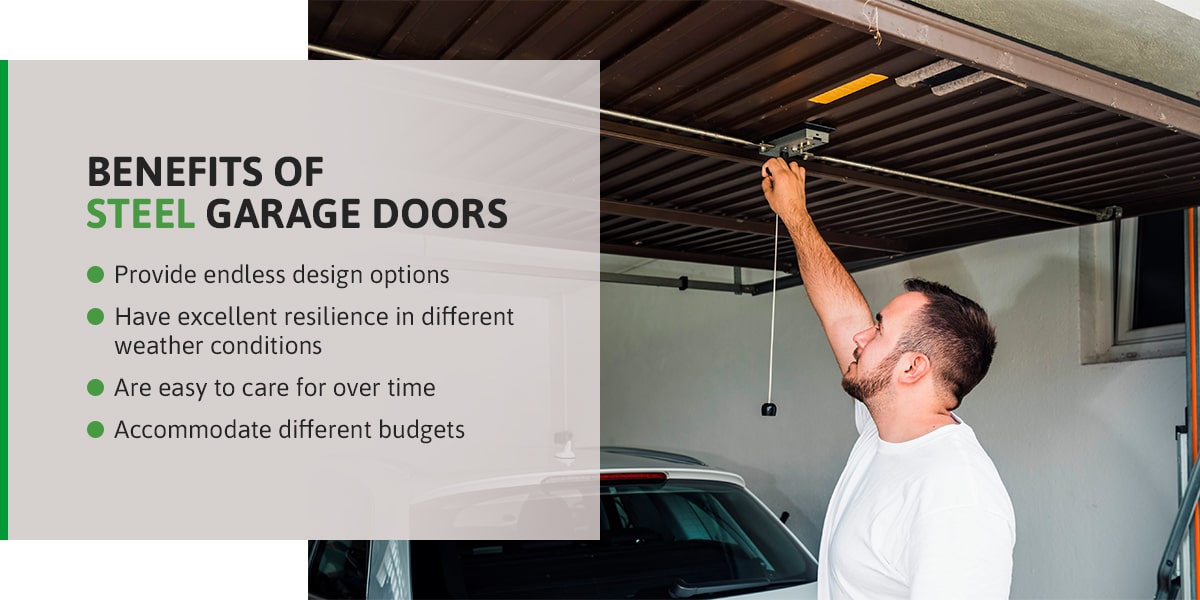
Benefits of Steel Garage Doors
Steel garage doors are popular among homeowners because of their value, design flexibility and durability. Our steel doors:
- Provide endless design options: Steel garage doors come in various styles to complement your home’s overall design. Choose from many colors and finishes to get a garage door in your property’s existing color palette. This material has the flexibility to look high-end at a fraction of the price.
- Have excellent resilience in different weather conditions: Steel garage doors are suitable for any climate. They come in various insulation strengths, so they’re rougher and better suited for harsh weather conditions. Aside from the considerations of energy savings, if you plan on spending any time in your garage door, we recommended having your door insulated as Steel doesn’t naturally offer strong insulation on its own. Since steel is vulnerable to rust when exposed to salt, you may have to maintain it more diligently if you live in a coastal area or use salt to get rid of the ice on your driveway.
- Are easy to care for over time: Since steel garage doors are lightweight, they’re more convenient to maintain. You don’t need to repaint or reseal them to maintain the luxurious colors. You’ll need to wash it at least twice a year to get rid of the residue from salt in the air or on your driveway.
- Accommodate different budgets: Steel garage doors are generally more affordable than other materials. These products also come at various price points, depending on your need for insulation, style and durability. You can find a garage door made of steel that meets your budget requirements and lasts a long time, providing value for your home for many years.
Benefits of Wood Garage Doors
Wooden garage doors are best known for their luxurious appearance and timeless style. A garage door made of wood improves your home in the following ways:
- Adds warmth and charm to your home: Wood has an elegant, rustic warmth that complements any architectural or design theme. This material will always be in style, so it’ll look great on your home, even if you update the exterior in the future. Even though other garage door materials can resemble wood, authentic, natural wood has a unique aesthetic.
- Has plenty of design choices available: Wooden garage doors offer customization options, including wood species, finishes and panel designs, to give your home a one-of-a-kind garage door. Wood tends to develop a natural patina due to sun exposure, making your garage door even more special.
- Provides environmentally-friendly options: Wooden garage doors are suitable for mild climates. As an eco-friendly resource, wood is sustainable and recyclable, cutting down waste. Since this material is an excellent insulator, it saves energy and puts less strain on your HVAC system.
- Has long-lasting value: Even though doors made from wood tend to be more costly than other garage door materials, these high-quality products last a long time. Their excellent natural energy efficiency allows you to save money on your energy bills in the long run. Wooden garage doors are also unique and enhance your home’s resale value.
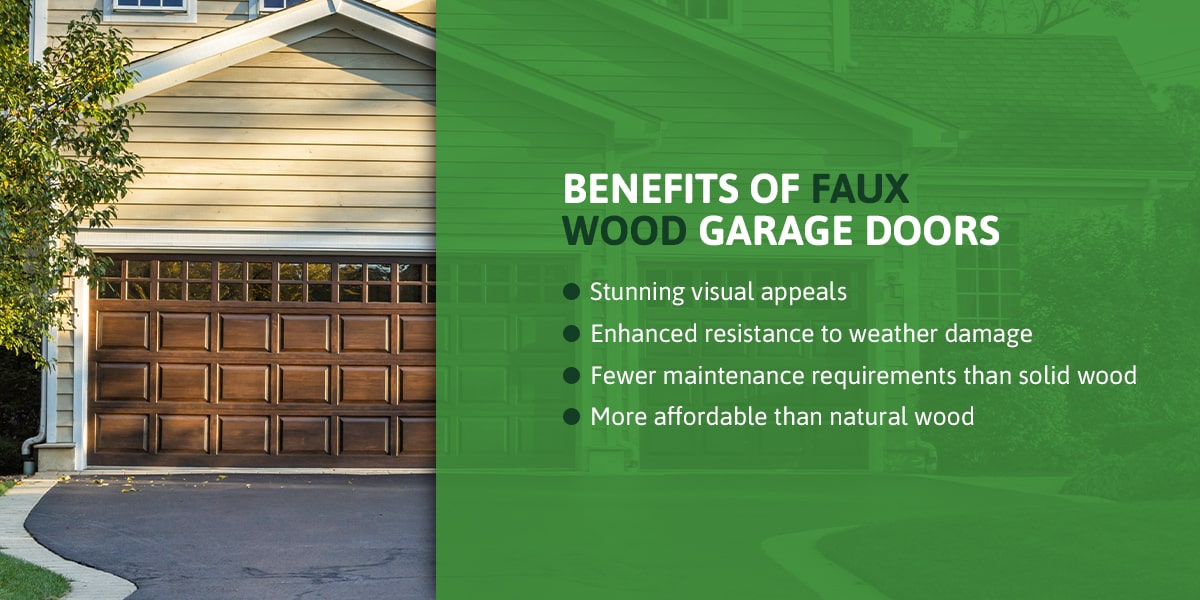
Benefits of Faux Wood Garage Doors
Faux wood, or wood composite, garage doors have similar qualities to wooden ones including the wood grain surface, but they’re a popular choice among homeowners for various reasons, including:
- Stunning visual appeals: A high-quality faux wood door can look almost exactly like a natural wood door, providing a warm, inviting aesthetic for your home. This material comes in various colors, finishes and panel designs to create a one-of-a-kind door perfect for your property’s unique exterior design. Our composite wood garage doors have pattern options that allow you to mix and match the overlay and the base colors. For new and existing homeowners looking to up their curb appeal, faux wood doors are always a great place to start.
- Enhanced resistance to weather damage: Composite wood is more resistant to moisture and temperature changes than natural wood. As you look for your garage door, make sure you shop at a store that offers high-quality faux wood products to give your home the ultimate protection. The plastic fibers in the faux wood panels increase their durability. Add insulation to your garage door to enhance its energy efficiency and resilience in different weather conditions.
- Fewer maintenance requirements than solid wood: Since wood composite is lighter than natural wood, a garage door made of this material puts less strain on your automatic overhead garage door opener. A faux wood garage door is easy to clean and keep clean due to its plastic fibers. Wipe the dirt and grime off the panels with a microfiber cloth, mild soap and water.
- More affordable than natural wood: A wood composite garage door is typically a budget-friendly option compared to solid wood doors. This lightweight material is lightweight and easy to install and maintain. Faux wood gives your home the aesthetic of authentic wood panels at a more affordable price point.
Benefits of Aluminum Garage Doors
Aluminum garage doors offer a sleek, modern look to your home’s design. This material can add value to your property, among other benefits, including:
- Accommodating a modern or contemporary style: Aluminum is usually suitable for contemporary or modern homes. An aluminum frame garage door features glass panels that bring natural lighting into your living space. This material comes with hundreds of color options to complement your overall design. There are also different glass type options, depending on your desired privacy and natural lighting.
- Resisting most weather conditions: Aluminum garage doors work well in any climate, but keep in mind that they’re sensitive to extreme heat. Since aluminum is resistant to corrosion and rust, you can install a garage door with this material in a coastal or rainy environment. Hail or strong winds can dent the aluminum, and a technician can repair them. Add insulation to your aluminum frame garage door and glass panes to make it more durable and energy-efficient.
- Being easy to clean and maintain: Aluminum is a relatively low-maintenance garage door material. Since it’s resistant to water damage, you can easily remove dust and other forms of residue with a garden hose and soap. The glass panels are also easy to clean with mild detergent and warm water.
- Fitting various budget options: Aluminum is typically less expensive than steel, but high-quality doors come at various price points. Whether you want a high-end garage door with additional insulation and security or a budget-friendly product offering basic protection, you can find what you’re looking for in an aluminum garage door.
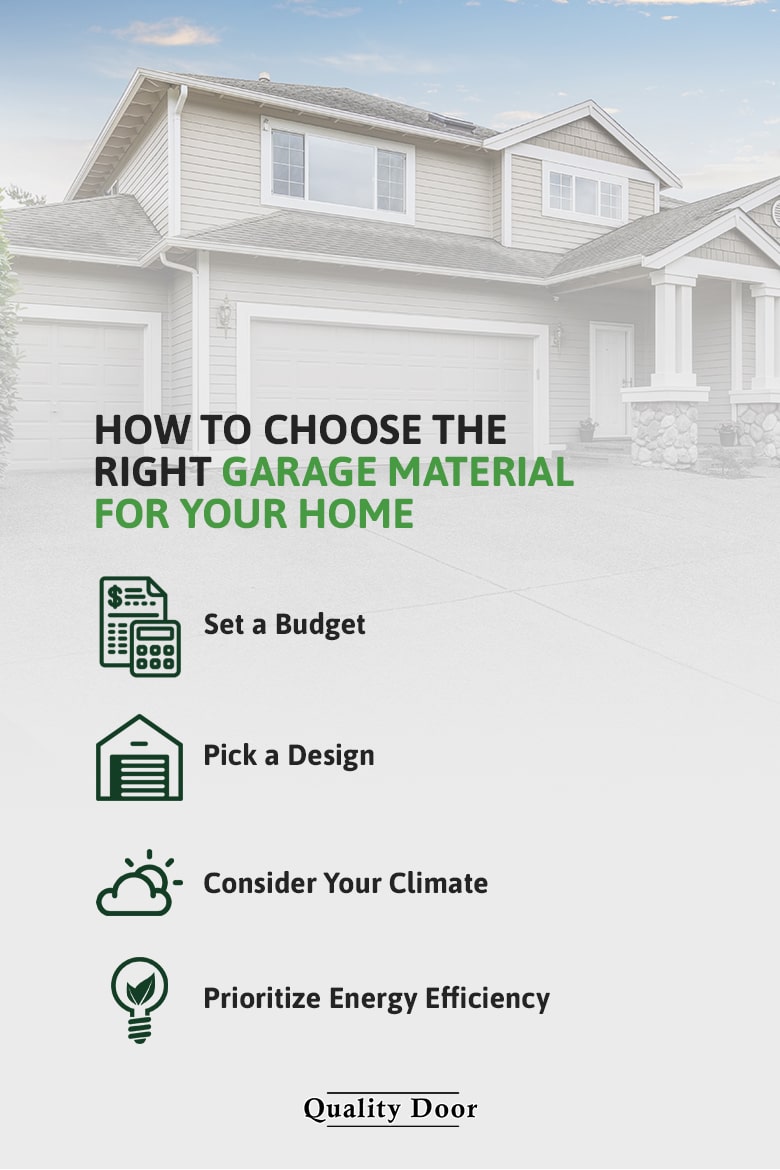
How to Choose the Right Garage Door Material for Your Home
Each material has advantages and disadvantages based on your unique lifestyle and design preferences. These factors can help you decide which garage door material is best for your home:
Set a Budget for Your Garage Door
Think about how much you’re willing to spend on a brand-new garage door. Besides the upfront cost, you’ll also need to consider how much you’ll pay in maintenance, energy bills and durability. A high-quality garage door lasts a long time, so you’ll save money instead of replacing the door in the next few years.
Pick a Design for Your Garage Door
Your garage door makes up a large part of your home’s exterior, and it plays a role in curb appeal. Look for a garage door that provides the desired look to complete your property’s overall design. Use the Door Imagination System to see how a garage door will look against your home if you need help figuring out your design preferences.
Design Your Dream Home with Quality Door Company
Consider Your Climate
Your garage door is supposed to protect your valuables and provide a convenient entry into your home. Your home’s local weather conditions can affect your door’s durability and life span. You may live in a coastal environment or a place with a lot of rain. In that case, it’s best to look for a material that withstands moisture. A low-maintenance material will also save you time and money in repair and care over the years.
Prioritize Energy Efficiency with Your Garage Door
Garage doors with insulation can help keep unpleasant air drafts out of your home and keep your living space comfortable throughout the year. Each garage door material has a different level of insulation capabilities to help you save money on energy costs and protect your valuables. You can typically add insulation layers to your garage door if you like the material but want something with a little more protection against the elements.
Request a Quote For Your Garage Door From Quality Door Company
Whether you know the best garage door material for your home, or you need some help nailing down your decision, we’re here to help. Our team at Quality Door Company provides high-quality residential garage doors for homeowners located in Western Michigan. Besides installing our high-quality products, we also offer repair and maintenance services for your existing garage door.
Send us a message online to request an estimate or learn more about getting your new garage door installed.
When to Replace vs. Repair Your Garage Door
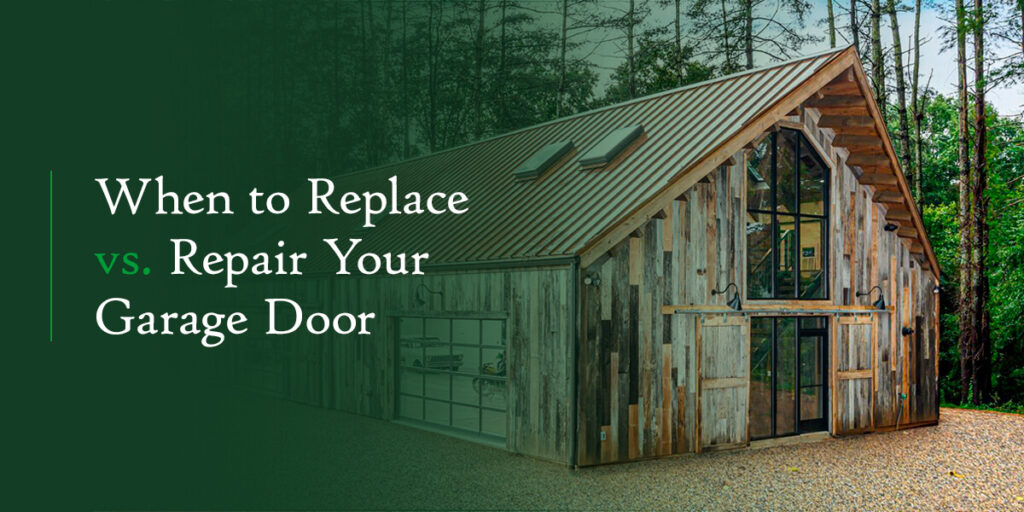
Purchasing a home is one of the most significant investments most people will make. Once you’ve settled into the perfect property, you want to grow or maintain your home’s value as much as possible. Whether you decide to sell your house or enjoy it for the rest of your life, thorough maintenance and repairs will ensure your home always looks as good as the day you bought it.
Garage doors make a considerable impact on your home’s appearance and functionality. Property owners often use them multiple times per day. Since your garage door likely represents a large percentage of your home’s facade, maintenance is essential to keep it looking beautiful and running smoothly.
Replacing your garage door has one of the highest returns on investment compared to other home improvements. In West Michigan, the ROI for a garage door replacement is 94.4%. A brand-new garage door can boost curb appeal, energy efficiency and security around your home. However, you may be able to salvage your existing door to achieve the same benefits with less expensive repairs.
This guide can help you decide the best way to refresh your garage door. Whether you choose to repair or replace, Quality Door Company can help you transform your garage door quickly and affordably to keep your home up to your standards.
Replacing vs. Repairing Your Garage Door
Deciding whether to repair or replace your garage door depends on many variables. Consider the following conditions to help you determine which is the better investment.
1. Does Your Garage Door Have Damage?
If your garage door has damage, the extent of the harm will help you determine whether you should repair it or get a new one.
Minor cosmetic issues like chipped paint or a small scratch are fairly easy to repair. You may be able to repair broken parts like springs instead of getting a new door. For moderate to severe damage that affects the door’s function, you may get more value out of a replacement garage door.
Watch for these signs to determine if your door has severe damage:
- The door makes loud noises.
- A panel is cracked.
- The door opens unevenly.
- There is rust on the door.
- The door gets stuck opening or closing.
- It is harder to lift the garage door than usual.
- A damaged garage door can be unsightly and may not function properly. You rely on your garage door to serve many purposes, so it is critical to have it fixed or replaced as soon as possible. At Quality Door Company, we can provide a free estimate and help you determine if the
- damage is a reason to replace or repair your garage door.
2. Energy Costs of Your Garage Door
A correctly sealed and insulated garage door will help maintain your home’s internal temperature and save money on your energy bills.
If you notice your energy bills are creeping up, your garage door might require some attention. If your weatherstripping is coming off and letting in drafts, a maintenance specialist may be able to reseal it and return it to its original energy efficiency.
An older garage door may not have enough insulation to prevent your heating and cooling from escaping. In that case, you might want to order a replacement with a thick layer of insulation. A new garage door can help your HVAC run less, which will help bring your energy bills back down.
3. Consider the Age of Your Garage Door
A high-quality, correctly installed garage door should last for about 30 years of typical daily use. If it’s possible to keep fixing your vintage garage door, but it’s reaching the end of its lifespan, it may save time and money to replace it instead. Keep track of the most recent installation to help you determine when to repair or replace your garage door. Replacing an old garage door can modernize your home’s aesthetic and include innovative convenience and safety features.
4. Cost
Deciding between a repair or a replacement for your garage door may also depend on cost.
If you lack the budget to replace your garage door, you can make the minimum repairs to keep it working while you save enough for a new one. Quality Door Company has a wide range of beautiful and affordable options.
If it costs more to repair your old door than it would to buy a new one, replacing your garage door is the obvious choice.
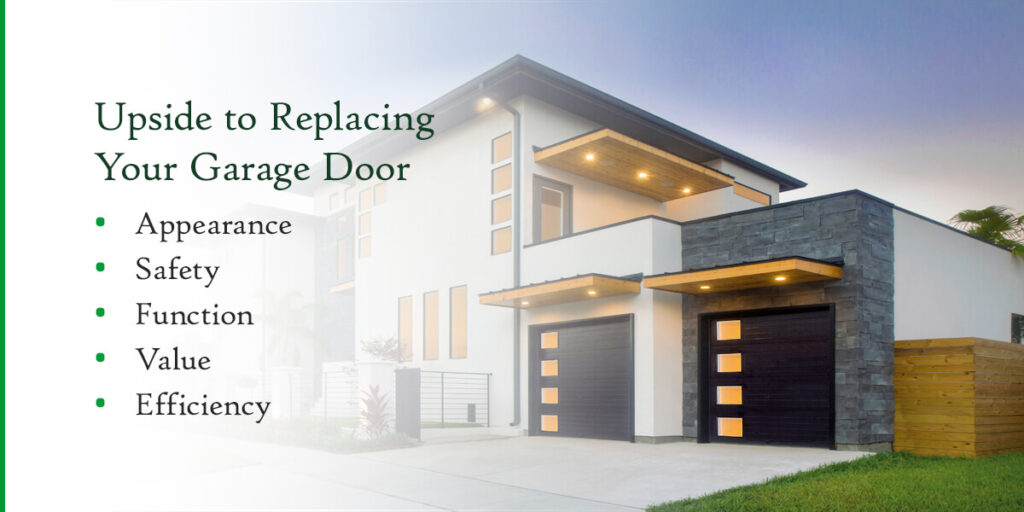
Upside to Replacing Your Garage Door
Replacing your garage door is an investment, but it is a worthwhile expense that will benefit your home and family. Here are some of the upsides to replacing an old garage door.
- Appearance: Garage doors take a significant portion of your home’s exterior, and an upgrade will enhance its curb appeal.
- Safety: Modernized garage doors, when combined with a new garage door opener, include safety features like an automatic reversal system that will bring the door back up if it detects a child or pet underneath. Some models also come with more advanced locks and alarms to keep intruders out.
- Function: Old garage doors can malfunction more often, and constantly scheduling repairs can be a headache. A new garage door is reliable and will operate smoothly with minimal maintenance.
- Value: If you choose to sell your home, a new garage door may earn you more money. A replacement is cost-effective, and real estate agents estimate it can boost your home’s perceived selling price by 4%.
- Efficiency: Garage doors protect a large opening between your home and the elements. Winters in West Michigan can be frigid, and a new garage door can help retain heat, so your family stays warm.
Preventive Maintenance of Your Garage Door Is Crucial
Maximize your investment with preventive maintenance that will help your garage door continue to function smoothly. If you can catch minor problems before they grow into costly issues, you can save time and money.
Regularly inspect your garage door to catch worn-out parts before they break and possibly cause further damage. Evaluate cables, pulleys, springs and other mechanisms that open and close the door. If you discover any loose hardware, you can tighten it to make sure everything stays in place. Clean out the tracks and rollers to prevent debris from clogging the door. Add lubrication to avoid friction between parts that can cause elements to wear down.
Your Reliable Garage Door Experts
If you would prefer to leave it to the professionals, you can schedule a visit from our team at Quality Door Company. Our experienced technicians perform installations, repairs and regular maintenance to extend your garage door’s life.
Quality Door Company has excellent products and dependable technicians who provide fast and friendly service. Whether you decide to repair or replace your garage door, we can help get your garage door back up and running to enhance your home and protect your family.
If you live in Muskegon, Grand Rapids, Holland or South Haven, Quality Door Company can help keep your garage door up to standard. Request an estimate or schedule service today!
Garage Door Buying Guide: How to Choose a New Door
No longer used for vehicle storage alone, today’s garages are a hardworking extension of the American home. Garages hold beloved holiday decorations, withstand creative art projects, corral sports equipment — and yes, keep cars safe and secure. With families reevaluating how to maximize their usable square footage during the pandemic, garages need to be energy-efficient, multifunctional spaces for work and hobbies.
Compared to other home improvement projects, a new garage door yields an astonishing 93% return on investment, or ROI, so you can rest assured it’s one of the wisest investments you can make. Before you shop for a new door, use this handy garage door buying guide to choose one that’s the perfect fit for your home.
6 Tips for Selecting a New Garage Door
With so many styles to consider, the process of choosing the best garage door isn’t always easy. Fortunately, through careful planning, you can rest assured your decision is the right one. Work with an experienced garage door supplier to discuss measurements, selections, installation and warranties and use these tips to find the best residential garage doors 2021 has to offer.
1. Pick a Garage Door Style to Complement Your Home
Knowing how to choose the best garage door style for your home starts with understanding the architectural style of your house. Your door should look cohesive with the time period, design and finishes of your home exterior. Many of these door styles can be modified with window styles that complement your living space. Stop by one of our showrooms to explore these popular garage door designs:
- Contemporary garage doors: Contemporary garage doors are the perfect choice for mid-century modern and minimalistic homes. Clean lines and elements of glass, metal and wood seamlessly complement the mixed-material trend found in modern-style homes.
- Traditional garage doors: A popular choice, classic style doors suit a wide range of home exteriors. Characterized by rows of raised rectangular panels, traditional garage doors are a cost-effective, versatile choice for neoclassical, colonial, Victorian and French country home styles.
- Carriage house garage doors: Aptly named, carriage doors’ “barn style” look originated from barn doors that could swing wide enough to accommodate horses and carriages. Carriage house garage doors are ideal for farmhouse, craftsman, mission and transitional homes.
2. Determine the Best Garage Door Material for Your Security and Maintenance Preferences
With numerous advances in garage door manufacturing, which materials are found in the best garage doors in 2024? When evaluating your customization options for your new garage door, consider the different door maintenance requirements that come with the different garage door styles.
To determine how to choose a garage door material, consider your maintenance preferences and the following qualities:
- Wood: If the material or historical accuracy is your top priority, wood doors may be ideal for you. While there’s no denying its beauty, some homeowners avoid natural wood because it requires periodic painting and sealing. For a maintenance-free option, consider a steel or composite door that resembles a wood texture.
- Steel: By far the most popular garage door material, steel is cost-effective, durable, dent-resistant and long-lasting. Steel offers superior security and can withstand extreme climates. Backed by rigid foam insulation, steel garage doors provide strength while remaining lightweight.
- Composite: Steel doors with composite overlays provide the durability of steel with the realistic feel of wood. For the look of wood without the upkeep, steel composite doors are a great choice.
- Aluminum and glass: Aluminum is ideal for coastal climates. While salt spray can prematurely rust steel, aluminum won’t rust in oceanic air. Aluminum and glass doors let in sunlight, perfect for modern homes and garage spaces used as work studios. Without insulation material, aluminum doors are also prone to heat loss which can increase your energy cost; for this reason, we don’t recommend them for withstanding Michigan’s cold weather.
3. Consider Insulation Value and Energy Efficiency for Your Garage
You’d benefit significantly from an insulated garage door if:
- The garage is attached to your home.
- You live in a three- or four-season climate.
- Winters are frigid, or summers are scorching.
- You use the garage as a workshop, laundry area or other functional space.
- A level of finished space, like a guest room, exists above the garage.
A well-insulated door can keep a garage warm on a cold winter day and prevent cool air from escaping in the summer heat. As a resident of Western Michigan, we highly recommend considering garage door insulation when choosing your next door. Insulation minimizes drafts and thermal energy transfer. As a result, homeowners who install insulated doors save on their heating and cooling bills.
Keep in mind that not all insulation is created equal. Review the certified R-value of the door. The higher the R-value, the greater the garage door’s performance — and the more significant the energy efficiency.
4. Select the Finish and Color of Your Garage Door to Improve Curb Appeal
A fresh garage door enhances the beauty of your garage and entire house exterior. The right finish increases home value for years to come, while a poor color choice can have an adverse effect.
Keep these tips in mind to select the perfect finish:
- Avoid front-door competition: Think of your garage doors as backup dancers to the main star of the show — your entry door. Match your garage door color to the house exterior or window trim to complement — and not outshine — your entry door. Coordinate, don’t compete.
- Bypass bold color: A vivid hue on a front door can perk up a tired entry, but it’s best to avoid bold color on a garage door. Because garage doors take up as much as one-third of a front facade, intense colors can overwhelm.
- Choose a timeless color: Yearly color trends come and go, but classic tones pass the test of time. Clean and timeless, white is the most popular color. Consider neutrals like beige, gray or black, which offer a change from standard white. For exteriors with natural materials like stone, warm browns and wood stain are inviting door finishes.
5. Add Finishing Touches to Your Garage Door for a Custom Look
As the “jewelry” of garage doors, hardware and windows add that custom look.
Hardware visually connects your garage doors to other metallic finishes on your home — seen on exterior lanterns, fencing and roofs — to create a cohesive aesthetic. Garage door manufacturers offer numerous decorative door hardware styles, including:
- Handles
- Door knockers
- Brackets
In many cases, hardware selection and installation are optional. If you fall in love with a carriage house door that traditionally includes iron-look hinges, but you prefer a cleaner look without the hardware, ask your door provider about customization.
Garage door windows add character and let in an abundance of natural light. For homeowners in high-wind areas, impact-resistant glass options are available. If privacy is a concern, rest assured that glass can be tinted, mirrored or frosted to give you the benefit of light with protection in mind.
6. Remember the Garage Door Opener
Doors don’t automatically come with openers, so remember to talk to your door provider about garage door openers. Automatic openers offer several benefits:
- Safety and accessibility: Unlike manual doors, automatic openers help people safely open doors regardless of their range of motion, preventing potential injury.
- Convenience: You can open your garage door without leaving your vehicle during inclement weather conditions.
- Lighting: Most openers include automatic lights when the door is in use, preventing stumbles in an otherwise dark garage.
Benefits of a New Garage Door
A new garage door can breathe life into your home and inspire you to tackle those other value-adding projects like landscaping or a paint refresh. No matter which door you select, you’ll enjoy these benefits when you decide to purchase a new garage door:
- Improved curb appeal: When you invest in your garage doors, you instantly update approximately 30% of your house’s exterior — that’s a significant improvement!
- Increased home value: According to the most recent Remodeling Impact Report by the National Association of the Remodeling Industry (NARI), updated garage doors increase home value and offer a high ROI of more than 95%.
- Energy savings: Replacing an older, uninsulated garage door with a new, energy-rated model can reduce garage energy loss.
- Security: New garage doors connected to quality openers offer superior protection to older, manual entries. Some door openers offer self-closing systems, so if you forget to close your door, it’ll shut it for you.
Contact Quality Door Company for Garage Doors Done Right
Are you looking for help with how to choose the best garage door? We can help.
With more than 30 years of experience, you can trust our expert technicians to provide the professional advice, attention and care you deserve. As a Clopay Master Authorized Dealer™, Quality Door Company is dedicated to providing the highest quality of garage doors and service to communities in Southwest Michigan.
To get started on a garage door upgrade that’s as resilient as it is beautiful, shop our residential garage door collections or contact our friendly staff today!


